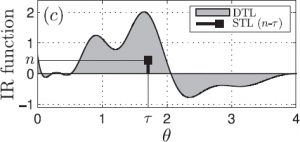Distributed Time Lag Response Functions for the modelling of Combustion Dynamics
Subramanian, P., Blumenthal, R. S., Polifke, W. & Sujith, R. I.,

Abstract:
The present study models a thermoacoustic system in the time domain where, in the limit of small amplitudes, the linear dynamics of a heat source is incorporated in terms of a distributed time lag response function. This approach allows for a description of the heat source that is richer than that in single time lag models such as the wellknown n–τ model or modifications thereof. Methods to extract the distributed time lag response function from numerical/experimental frequency response data and to conduct a linear stability analysis for distributed delay differential equations are described in this work. The theory is applied to the test case of experimentally measured frequency response data of a turbulent premixed swirl flame. The use of a distributed time lag response function model for the heat source is shown to contain the entire dynamics of the heat source, as all characteristic timescales of the flame response are inherently reflected in the response function itself. It therefore gives an accurate estimate of the linear stability map in addition to generating valuable insight into the physics behind the transient flame dynamics. In contrast, we show that a single time lag model can only yield correct stability predictions if the unstable eigenfrequency of the system is known a priori with good accuracy.We also show that a single time lag model is in general not capable of capturing the transient dynamics of a thermoacoustic system correctly. It is concluded that the linear response of the heat source in a thermoacoustic system should be represented in terms of a distributed time lag response function rather than a single time lag model, with a view to retaining the rich complexity that is available even in such a low-order model for the heat source.
Publication details: Combustion Theory & Modelling, vol. 19(2), pg. 223-237, 2015.
